Convict Cichlid is one of the interesting freshwater species among the Cichlid kind. This species is prevalent because of its low-key maintenance. They are mainly from Central America; however, they are now famous worldwide. And one can easily find them in the local species market or buy them online. Convict Cichlid has become the go-to fish among the Aquarist and the aquarium sector for many years.
Convict Cichlid is suitable for beginner to pro Aquarist. However, our article will fit you perfectly if you want to drive deep into Convict Cichlid. As in our article, we will illuminate you on the species’ appearance, care, breeding, and tank size. So, without further ado, let’s begin.
Table of Contents
Convict Cichlid: A Complete Guide
Convict Cichlid is a much-adored species among the Cichlidae species family. They are native to the central part of America. These species are mainly famous for their vibrant color, dynamic nature, low care involvement, and hardiness.
Among the least demanding fish is the convict cichlid. That is not all; they do not easily tolerate other types of fish and are more of an aggressive and semi-aggressive type. The male Cichlid is 6 inches, and the female is 4.5 inches long. Usually, their size is small, and they can easily fit into a 30-gallon tank.
Convict Cichlid can live 8 to 10 years, and they have an appealing look. The fish comes in small to medium size and is aggressive. The fish is cost-effective, and anyone can buy them from the local markets or online stores by spending only $5 to $12.
Nevertheless, if you are a fish enthusiast and want to add a new member to your aquarium, Convict Cichlid is the perfect one for you.
Convict Cichlid Overview
As a freshwater species, Convict Cichlid is one of the easy-care species that is worth adding to your water tank. These species belong to the Central America region; however, they are available worldwide. Convict Cichlid is a prevalent species that can undoubtedly enhance the beauty of your water tank. As they are aesthetically beautiful to watch, having a Convict Cichlid for your aquarium will never fail to make you feel delighted and add more charm to the aquarium.
As previously mentioned, Convict Cichlid is native to Central America; we can find them in Guatemala, Panama, Costa Rica, Nicaragua, El Salvador, Honduras. These species enjoy a running and firm stream of fresh water and choose a rock and growing plants to hide.
The scientific name of Convict Cichlid is Amatitlania nigrofasciata, and they are active and fun to watch. Interestingly, if you notice, you will see black stripes in their full-body like the Convict’s dresses’. That is why we mention them as ‘Convict’ Cichlid. Apart from that, they are called Zebra Cichlid for their appealing look.
They are available in black and white colors. However, one can find them in pink gold as well. That said, female Convict Cichlid is more colorful than the male ones. These species can live up to 10 years, suitable for any enthusiastic fish.
It also boasts of an engaging personality. Many hobbyists love to observe how the couples take proper care of their juveniles. The couple loves to be in their tank, especially when they have their young ones about.
Now, let’s have a look at a Convict Cichlid.
Well, apart from the coasts of the Pacific and Atlantic, we can see Convict Cichlid in Australia and a few countries that have the natural habitat of Convict Cichlid. They are suitable for 30-gallon tank sizes.
Let us quickly check out a few factors related to Convict Cichlid to remember easily.
| Information Chart | Convict Cichlid |
| Scientific Name | Amatitlania nigrofasciata |
| Other Names | Zebra Cichlid |
| Family | Cichlidae |
| Origin | Central America |
| Care Level | Easy |
| Temperament | Aggressive to semi-aggressive |
| Color | white, black |
| Lifespan | 8 to 10 years |
| Size | 4 to 6 inches |
| Diet | Omnivore |
| Minimum Tank Size | 30 gallons |
| Temperature | 74℉ to 84℉ |
| Water Hardness | 9 to 20 dkH |
| pH Range | 6.5 to 8.0 |
| Water Conditions | Fresh water in the tank |
| Compatibility | Aggressive to semi-aggressive |
Origin
Scientifically known as Amatitlania nigrofasciatus, the Convict Cichlid is native to Central America. Countries that harbor the fish include Guatemala, Costa Rica, Panama, and Atlantic slopes found in Honduras. In the IUCN Red List, the convict is not featured.
The convict cichlid dwells in rocky areas with caves to hide away from predators in its wild habitat. They also hunt for their food in rock crevices. Other places they dwell in include springs and warm pools. They rarely settle in open areas.
The Appearance Of Convict Cichlid
As described earlier, the fish enjoys colorful black and white stripes on its body. Some people have even nicknamed it the Zebra Cichlid. And the number of stripes is approximately 8 or 9. It has an almost oval, stocky shape. It also spots pointed anal as well as dorsal fins.
The Convict Cichlid is often compared with the African Cichlids as both look alike, but they have differences in color and pattern.
The males can reach lengths of up to 13 to 15 cm. On the other hand, females are slightly smaller and can reach 8 to 10 cm in length. Their varying body sizes make it easy to identify males and even females.
These fish have visible and prominent dorsal and anal fins, making them look like a sail while they swim. Hence, this makes them more attractive to pay attention to.
Color Of Convict Cichlid
This fish comes in various colors: pink, white, and the pseudo albino variety. Cream convicts are available as well. The male colors are more monotone, while the females have spots and orange patches on their stomachs.
Convict Cichlid: Male And Female Differences
There are a few prominent differences between the male and female Convict Cichlid. Although, both of the genders need to reach a specific size to develop the differences. Now, let’s know a few differences between male and female Convict Cichlid.
- Firstly, in terms of colors, we can differentiate between male and female as males have fewer color varieties than the female Convict Cichlid.
- Usually, male Convict Cichlid can grow up to 6 inches, and females can grow up to 4.5 inches.
- Female Convict Cichlid gets an orange sign in the dorsal fin and belly part when it grows up, while the male gets a hump in the head when it grows up.
- Lastly, male Convict Cichlid behaves more aggressively than his partner.
Lifespan Of Convict Cichlid
The typical lifespan of a Convict Cichlid is 8 to 10 years. However, they can live more than 10 years if properly looked after and cared for. To increase the lifespan and keep them healthy, we recommend you be careful about the species you want to keep as your Convict Cichlid’s tankmates. Predatory tank mates can lead to your cichlid’s early death.
Convict Cichlid Size
The male and female Convict Cichlid have different sizes. Although the typical male Convict Cichlid grows up to 6 inches, the female grows up to 4.5 inches. These species come in small sizes compared to the other members of the Cichlidae family. So, one can put them in a short-spaced aquarium too.
Natural Habitat, And Origin
Now, coming to this part, an essential factor about Convict Cichlid is that they require natural habitat to sustain in the aquarium. So, one must consider this factor attentively and recreate their natural habitat.
As native to the central American part, Convict Cichlid enjoys warm, steady water and sand and rock substrate in the water. They also prefer rocks and plants to hide beneath them. Hence, if you decide to have them in your aquarium, ensure to provide them with their natural habitat. Without that, they may not survive longer. Additionally, you can use rocks and plants to provide slow-motion current in the freshwater.
Convict Cichlid Care, And Tank Set-Up
The tank setup is the most crucial part of welcoming Convict Cichlid. However, it needs to be done with the utmost so that your favorite species can last long. As Convict Cichlid gets along with the warm water of central America, maintaining the adequate water temperature, hardness, pH level is necessary. Let’s now see the tank size and other aspects.
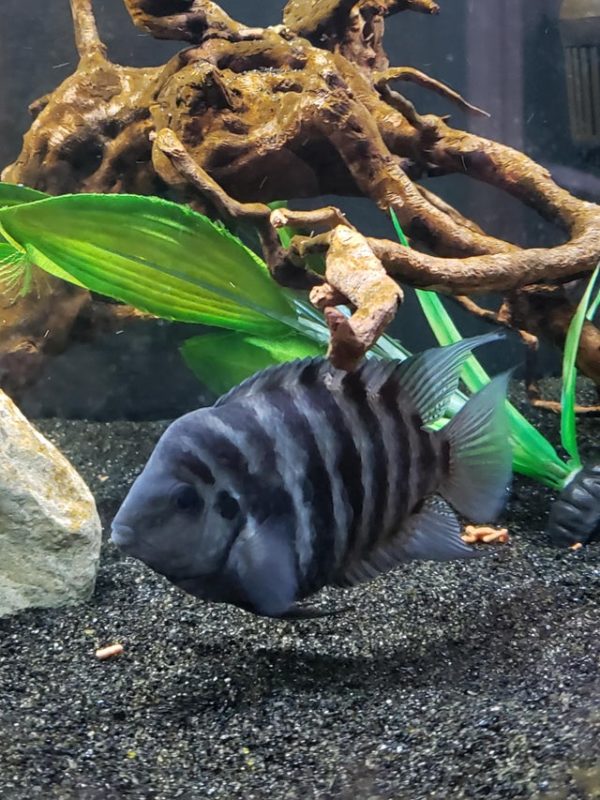
Convict Cichlid Tank Size And specifications
The Convict Cichlid is an aggressive species that enjoys space. However, you can keep two baby Convict Cichlids in the 20-gallon water tank. But, you would require to set up a new tank as they grow up. It is said that a 30-gallon water tank is better for them. However, managing a 40-gallon aquarium for two Convict Cichlids is more than pleasant.
Optimum Tank Size For Convict Cichlid
As Convict Cichlid is prone to aggression, keeping them in an ample space is always better. With that said, a 40-gallon water tank will do the work. However, the recommended optimum tank size for Convict Cichlid is 50 gallons.
Tank shape For Convict Cichlid
As Convict Cichlid prefers freshwater, recreating their natural habitat is essential for their survival. A large-sized tank of at least 20 gallons for a juvenile. If the fish is slightly more significant, the tank should be between 40 and 50 gallons. The tank should be even more significant for two large-sized convict cichlids about to breed.
Substrate
Using substrate to layer the tank floor is fundamental. So, putting some sand on the rock will be helpful. However, do not forget to add some rock, plants, driftwood in the water tank to help the fish survive.
The fish tends to dig things, so they will not have any scratches if sand is used to make the substrate.
How Many Convict Cichlid In 40 Gallons?
Well, you can put a pair of Convict Cichlid in a 30 or 40-gallon water tank. However, choosing a 50-gallon water tank would be best for them as more space can keep them happy and healthy.
Water Parameters For Convict Cichlid
The Convict Cichlid prefers various water parameters, hardy fish. And making sure that you know their ideal water parameters is vital.
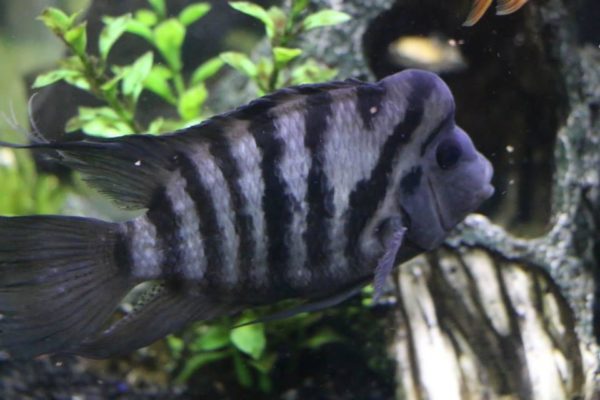
They go along with the ideal water temperature in between 79℉ to 84℉. To keep them healthy, you should offer them the following tank parameters to keep them active and healthy.
- Need good water movement
- Require freshwater
- Warm brackish water
- pH range of about 6.5 and 8.0
- Water gravity of not less than 0.0002
- Moderate to low light
- The salinity of about 10% of the average water
- Water hardness should be 10 to 15 dkH.
Convict Cichlid Tank Landscape
Recreating the natural habitat of Convict Cichlid is the most challenging task.
To begin with, you are required to have a 40-gallon water tank for them. Also, maintaining the proper water parameters is essential.
It is required to add some vegetarian plants that cannot be disturbed while the fish digs it up. You can add Java Fern, Anubias, Java Moss in the water tank.
Convict Cichlids are happier when you offer them a larger tank space with plenty of rock crevices to hide in. At the bottom of the tanks, put some rocks with crevices, driftwood, roots, and sand. Have some floating plants to provide a canopy. They love to swim in tanks with subdued lighting conditions. Since they are aggressive, ensure the plants are well anchored.
Additionally, you can layer up the aquarium floor with sandy and rocky substrate. Also, provide a good current in the water and light in the tank. Give them enough space to be active throughout the day so that you can always admire looking at them playing, hiding.
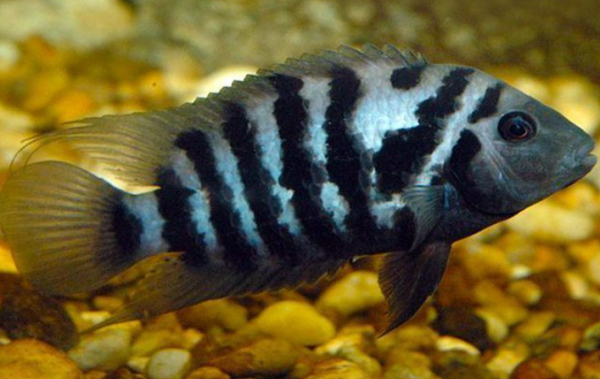
Diet Of Convict Cichlid
It is imperative to pay attention to their diet if you want them to sustain longer. Although Convict Cichlid is aggressive, they do not eat other fish. So, you can always put them with other fish too.
It is an omnivore that does not have many demands for feeding. No wonder why it is considered an easy fish to keep. The convict eats a variety of foods without a problem. The foods to provide include
- Worms
- Beef heart
- Frozen foods
- Frozen shrimp
- Cichlid pellets and flakes
- Vegetables like spirulina and blanched lettuce
How Often Should You Feed Convict Cichlids?
Feed small amounts of food to these fishes at least twice each day. Ensure the food is in small, easily digestible pieces. Add supplements to help in their overall health. You should not forget the vitamins.
Convict Cichlid Behaviour, And Temperament
Knowing your Convict Cichlid’s temperament and behavior will help understand their care. As previously mentioned, they are aggressive and semi-aggressive by nature, which means you can put them in a proper water environment without concern. Avoid putting slower and significantly weaker fishes with these cichlids, as they can eat them up.
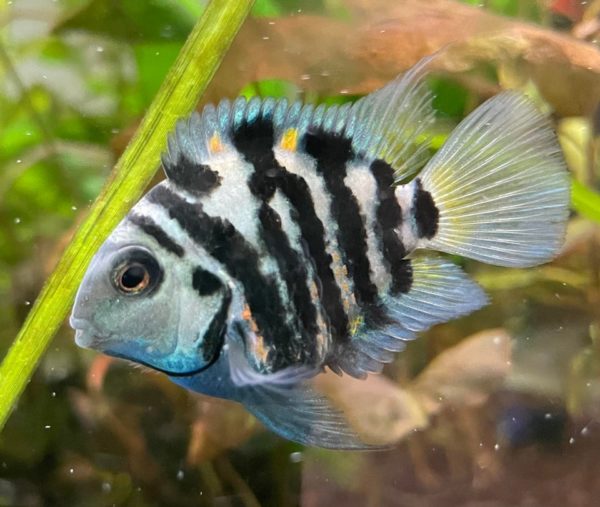
Needless to say, the role of the right kind of water tank setup is undeniably true to maintain them. That is why adding rock driftwood is important to provide their privacy. It is also scientifically proven that Convict Cichlid tends to become aggressive when they do not get their natural habitat.
Now, if you manage to maintain and recreate their natural habitat in your 40-gallon water tank, you would never miss out on the entertainment they will provide you.
Are Convict Cichlid Lone, Or A Societal At Nature?
Well, Convict Cichlid prefers to live on their own throughout the day. But they go along with their partners, meet them, and place eggs.
Convict Cichlid Tank Mates
As a beginner, no Aquarist should put Convict Cichlid with the other species as this will lead to trouble. Also, avoid putting them with others in their breeding time. The male fish becomes more agitated at that time.
It is an aggressive fish that you can keep with other big-sized fish, which these cichlids cannot quickly push over. Hence, avoid housing it with peaceful fish species.
Fish types that can share a tank with the convict cichlid are Green Terror, Rainbow Cichlid, Blue Acara, Jack Dempsey, Oscar, Pictus Catfish, Clown Loach, Silver dollar fish, Giant Danio.
Breeding, Hatching, And Fry
Convict Cichlids are referred to as cave spawners. Unlike other types of fish that are difficult to breed in captivity, these have very few requirements to breed. The pair shake their heads in a fanciful dance before the male positions itself vertically. It turns a darker shade of color. The female dances then digs up places in the substrate for the female to lay her eggs.
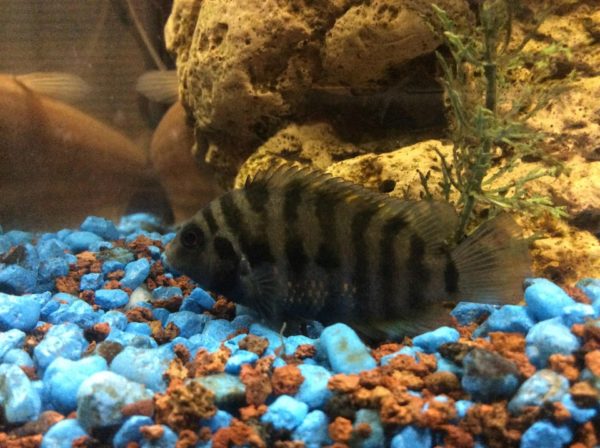
As soon as 20-30 eggs are laid, the male fertilizes them. It happens several times until the eggs are anywhere from 100-300. After the eggs are laid, the male keeps vigil. They are known to be very protective of both eggs and fry.
After 48-72 hours, the eggs hatch. After about a week, the fry can swim freely. They can be fed baby brine shrimp and powdered flakes. In about 3 weeks, the juveniles mature and feed on whole flakes.
During these times, the couples protect their young ones and are likely to be aggressive towards the other tankmates. It would be a good idea to keep other fishes separately during this time.
Common Diseases Of Convict Cichlid
The best part is they don’t usually suffer from diseases much, but it is highly recommended to keep an eye on them. And if you notice something odd in their behavior, change of color, slow feeding pattern, then constantly seek out the help of an expert.
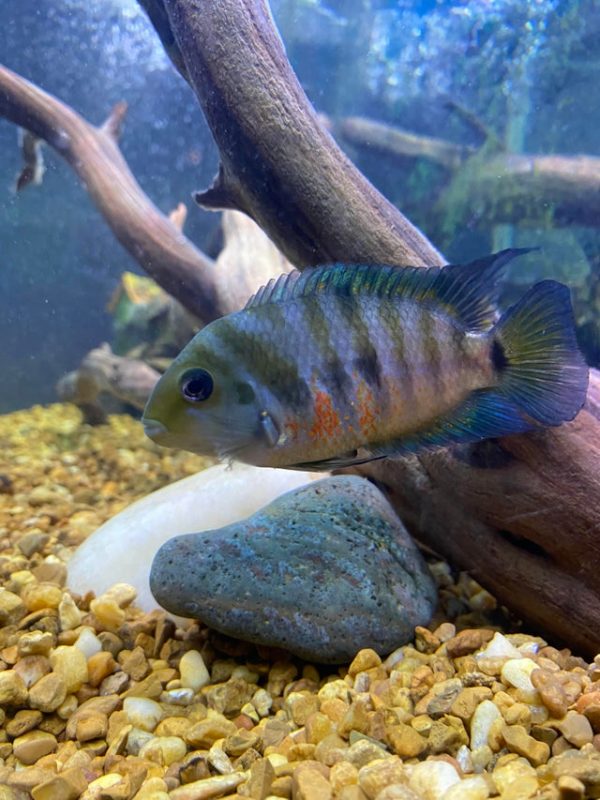
Facts About Convict Cichlid
- Convict Cichlid is an aggressive kind of species from Central America. And sometimes, they may live in their natural habitat regions like Australia and other places.
- It is ranked 3rd among the Cichlids, after Angelfish and Oscar. The name “convict” stems from the white and black stripes alternating on its profile. White and black stripes on garments worn by prisoners resemble that.
- Even though Convict Cichlid are known to spot stripes on their forms, body colors vary. While others are blue-gray, some are lavender, and others are cream. The dark bands run vertically around the body end somewhere near the head. One last band forms a ‘u’ shape close to the sparkling eyes. The convict fish fins are almost light yellow.
- Like all Cichlids, the Convict has well-developed teeth located in its throat. The regular teeth are found in its mouth too. Spiny rays are at the back of their pelvic, dorsal, anal, and pectoral fins that help keep predators at bay. The front parts of the fins are soft. They help with free yet effortless movement inside water. They are not fast swimmers.
- As opposed to other types of fish, the Convict has one nostril on either side of its head. After drawing in water, the fish samples the liquid to test certain smells before finally expelling it. Depending on the strength of smell, you can sample the water whether it takes a shorter or longer time.
- The Cichlid can live for about ten years or more. In the wild, some are known to live to be 20 years.
Is Convict Cichlid Right For You?
We hope by now you have got your answer. Convict Cichlid is an aggressive species that may not get along with many species. And if they are attacked or provoked, they may attack back. However, having them in your aquarium is not a bad idea at all.
Additionally, they require an easy to medium care level. They come in different colors and are always active. Beginners can keep them as well. Hence, you can add them as your aquarium pet but keep them in a separate aquarium if you have other fishes.
FAQ
How Long Does It Take For Convict Cichlids To Grow To Full Size?
Well, usually it depends on the breed, environment but a Convict Cichlid can take 2 to 3 years to mature.
Can I Keep One Single Convict Cichlid?
Yes, you can keep a single Convict Cichlid in the 30 or 40-gallon water tank. Keeping a male and female pair together is more common to breed. Hence, you may go for a pair too.
Is Convict Cichlid Happy Alone?
To answer that, a Convict Cichlid requires freshwater, food, and the right environment to grow. If they get them, they can live happily alone.
Conclusion
The convict cichlid is an interesting fish for the aquarium. Keeping it offers a hobbyist the opportunity to observe a rare phenomenon of couples protecting their fry.
